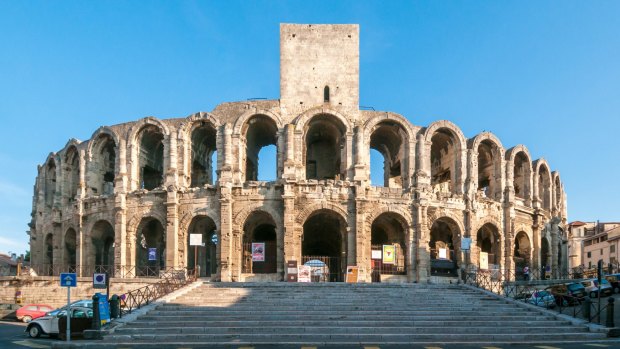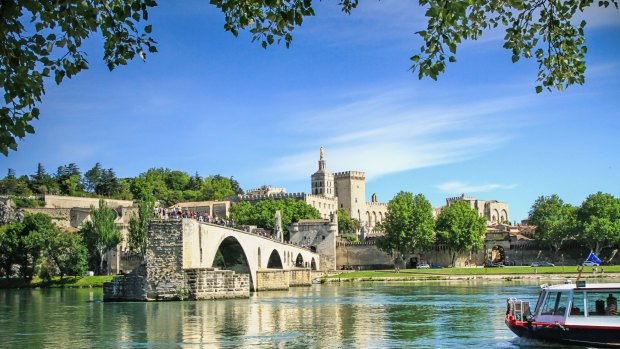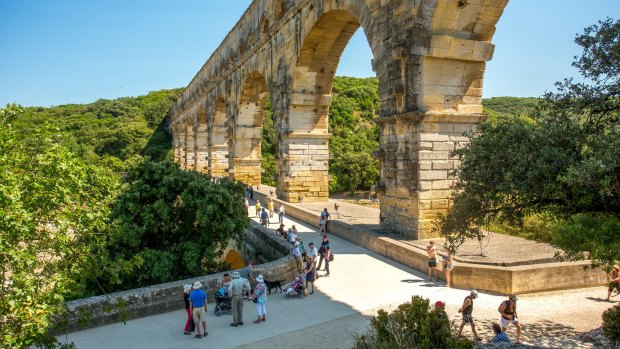This was published 5 years ago
Pont du Gard aqueduct and Roman ruins in Arles, France: Modern thinking, ancient marvel
By Keith Austin

The Roman amphitheatre in Arles.
Say what you like about the Romans but they certainly were careless, leaving bits of themselves scattered willy-nilly across Europe. Take southern France, where they littered the place with enough amphitheatres, temples and triumphal arches to last many lifetimes.
Oddly, this isn't the case in Avignon, which sits in a sort of golden triangle of former Roman glories such as Arles, Nimes and the startling Pont du Gard aqueduct near the cleverly named village of Vers-Pont-du-Gard.
Today, the Roman remains in Avignon have been mostly obliterated by subsequent sackings and invasions. There are remnants to be found if you look hard enough but unless you've got a hankering for wall fragments that look like they've been put together by a blind bricklayer it's probably best to concentrate on the city's medieval history (which is indeed glorious).

The Bridge of Avignon.Credit: Shutterstock
Avignon was very much a jewel in Julius Caesar's crown back in the day (49 BC) when it was very close to the Via Agrippa, one of the main Roman trading routes. The present-day Place de L'Horloge, a popular central square festooned with open-air restaurants, was the main forum of a town of 25,000 people.
Today it's a relaxed city of about 90,000, popular for its papal palace (seven popes lived here between 1309 and 1377), cathedral and, from I can make out, for being the place where all of Provence's famed lavender soap goes to die.
We are based in Avignon for two nights as part of a nine-day Wonderful France guided tour from Paris to Monaco and back again. It's a coach trip that starts with two nights in Paris before heading south via Beaune, Lyon, Cannes and Monaco.

Pont du Gard, a mighty aqueduct bridge rising over three arched tiers, built by first-century Romans.Credit: Shutterstock
Sadly, Avignon is the last port of call but for admirers of Roman architecture it's like they have saved the best for last. For just 45 minutes south of Avignon through rolling Provencal countryside sits Arles, which the Romans took possession of in 123 BC and turned into one of the region's most important cities.
Today, it's known for the completeness of its Roman ruins and also for being the place where, in a burst of creativity in 1888-89, Vincent van Gogh painted some of his best-known work.
Both of these are front and centre on our guided tour through a city which, in its Roman heyday was home to enough thermal baths and temples to be nicknamed the "little Rome of the Gauls". There's a Roman theatre in pretty good nick for something almost 2000 years old but the piece-de-resistance is the Arènes d'Arles.
Built in 90 AD, this impressive amphitheatre once held chariot races and gladiatorial battles in front of up to 20,000 people. Today, it's largely intact and is still in use as a concert and theatre venue. Take the time, if you go, to pay the entrance fee and explore the impressive interior.
On our last full day in Avignon we drive out to the three-tiered engineering marvel of the Pont du Gard aqueduct. Built in the first century AD to bring water to the city of Nimes from a spring at Uzes 50 kilometres away, it's shockingly well preserved and soars majestically over the Gardon river valley, somehow stolid and beautifully ethereal at the same time.
The novelist Henry James described it as "unspeakably imposing". While writer Hilaire Belloc, in 1928, wrote: "It looks as though it had been built long before all record by beings greater than ourselves, and were intended to stand long after the dissolution of our petty race … I confess to a great reluctance to praise what has been praised too much."
Ninety years later, he's not wrong.
TRIP NOTES
Keith Austin travelled as a guest of Trafalgar.
MORE
FLY
All of the major airlines operate frequent flights from Sydney and Melbourne to Paris Charles de Gaulle airport.
TOUR
Trafalgar operates throughout Europe and Britain. The nine-day Wonderful France guided holiday from Paris to Monaco and Cannes and back again costs from $3786 a person twin share. Prices include some meals, airport transfers, an expert travel director as well as local specialists along the way. If you book all seven optional experiences it will cost an extra €434 ($680). Visit trafalgar.com for more details.
Sign up for the Traveller Deals newsletter
Get exclusive travel deals delivered straight to your inbox. Sign up now.